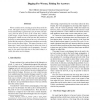Free Online Productivity Tools
i2Speak
i2Symbol
i2OCR
iTex2Img
iWeb2Print
iWeb2Shot
i2Type
iPdf2Split
iPdf2Merge
i2Bopomofo
i2Arabic
i2Style
i2Image
i2PDF
iLatex2Rtf
Sci2ools
ACSAC
2002
IEEE
2002
IEEE
Digging For Worms, Fishing For Answers
Worms continue to be a leading security threat on the Internet. This paper analyzes several of the more widespread worms and develops a general life-cycle for them. The lifecycle, from the point of view of the victim host, consists of four stages: target selection, exploitation, infection, and propagation. While not all worms fall into this framework perfectly, by understanding them in this way, it becomes apparent that the majority of detection techniques used today focus on the first three stages. This paper presents a technique that is used in the fourth stage to detect the class of worms that use a horizontal scan to propagate. An argument is also made that detection in the fourth stage is a viable, but under-used technique.
| Added | 14 Jul 2010 |
| Updated | 14 Jul 2010 |
| Type | Conference |
| Year | 2002 |
| Where | ACSAC |
| Authors | Florian P. Buchholz, Thomas E. Daniels, James P. Early, Rajeev Gopalakrishna, R. Patrick Gorman, Benjamin A. Kuperman, Sofie Nystrom, Addam Schroll, Andrew Smith |
Comments (0)

